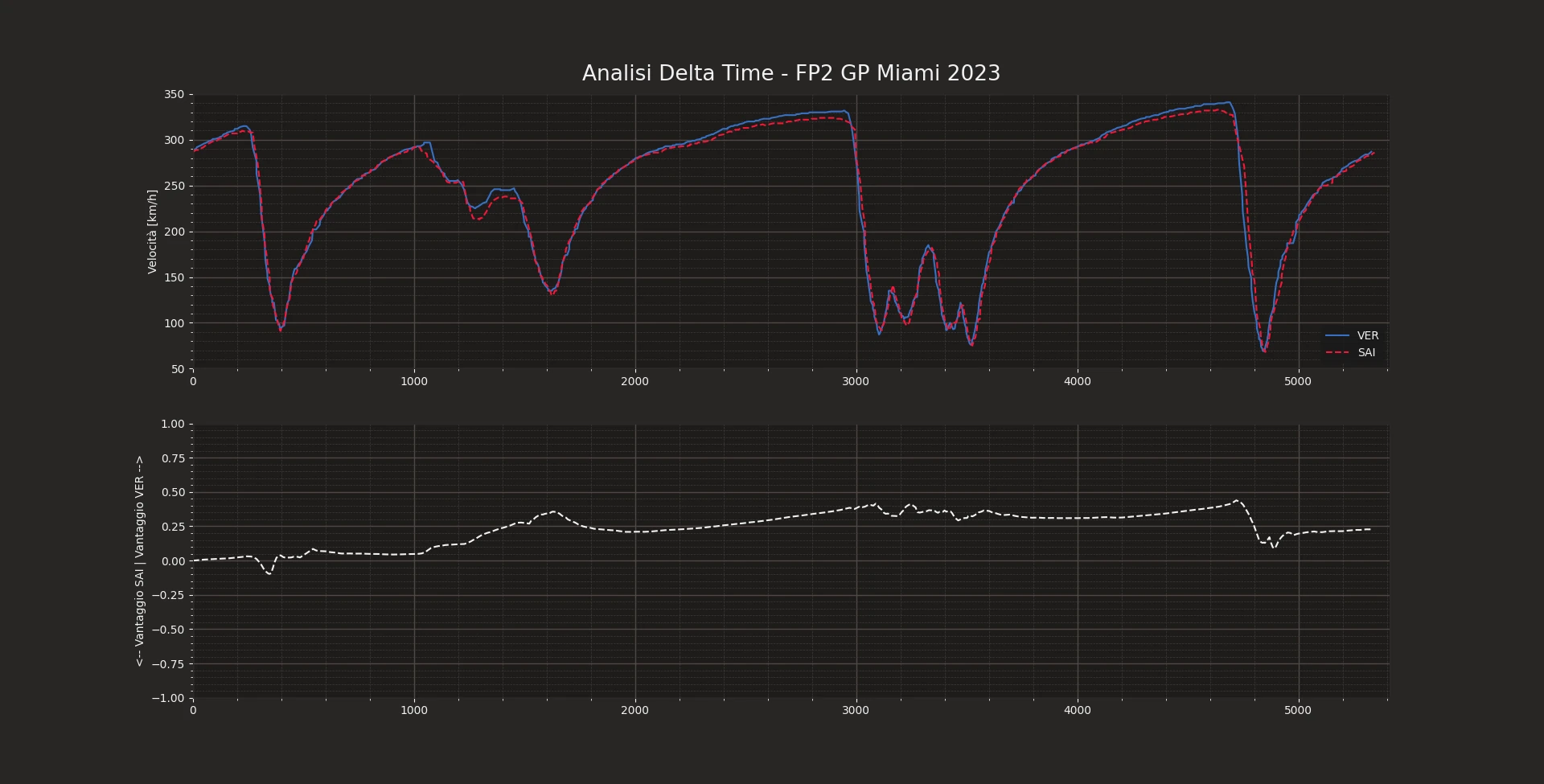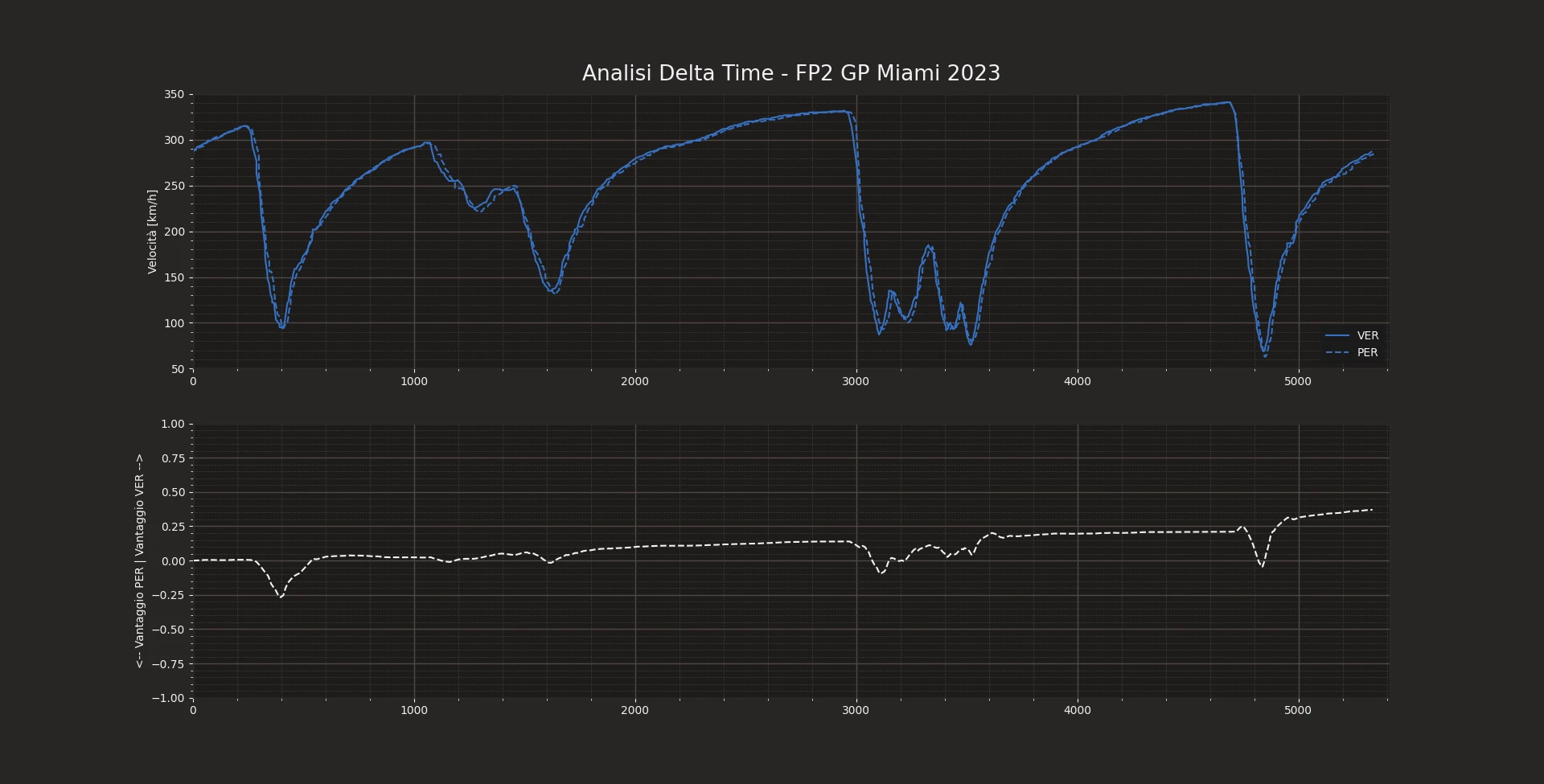
Analysis of the Friday in Miami: Mercedes fastest in FP1, then Red Bull and Ferrari come out on top!
At the end of FP1 in Miami, the first verdict from the track spoke of a Mercedes leading the group with a fair margin over its rivals from Ferrari and Red Bull (in that order). Of course, having fitted soft tyres in the final stages of the session, when the track was in optimal conditions, helped Russell and Hamilton a lot; however, the margin by which they kept behind the other cars gave the impression that there would have been a close fight…
Full classification from FP1 in Miami 👀#MiamiGP #F1 pic.twitter.com/joHtMk2WcB
— Formula 1 (@F1) May 5, 2023
Instead, as FP2 showed, for the teams of Leclerc and Verstappen there was still some margin to be extracted, as well as - to a minimal extent - for Fernando Alonso's Aston Martin. These are the results of the second free practice session:
FP2 CLASSIFICATION 👀
— Formula 1 (@F1) May 5, 2023
Verstappen on top heading into Saturday #MiamiGP #F1 pic.twitter.com/hjOlLXjEfp
What does it take to be fast in Miami?
The track built around the Hard Rock Stadium in Miami requires a medium downforce setup, since it includes both high-speed corners (mainly in the first sector) and three very long straights. In analyzing the performance expressed on track, therefore, it is necessary to take into account the fact that the optimal setup arises from a trade off between different needs:
- High downforce to perform well in the high-speed corners of sector 1;
- Low drag (and efficient DRS) to gain time on the straights of sectors 2 and 3;
- Good mechanical grip, to face the tight corners that connect the last two sectors;
It goes without saying that a single-seater hardly possesses all these characteristics at the same time, so - as often happens on "blended" circuits - it is those cars with high aerodynamic efficiency that emerge.
Telemetric Analysis: where does Red Bull gains over Ferrari?
We have repeatedly said this year that the most efficient single-seater on the grid is the Red Bull RB19, which can be more advantageous in the race than in qualifying: given the natural qualities of the English-Austrian team's car, the performance of the Ferrari SF-23 is even more surprising, in the hands of Carlos Sainz as well as when it's Charles Leclerc behind the steering wheel.
So let's analyze with the telemetry where the advantage of Max Verstappen (1'27"930) over the first of the two Ferraris (Carlos Sainz in 1'28"315) lies...

Verstappen (Red Bull) and Sainz (Ferrari) best lap telemetry comparison
As can be seen, in the first sector the entire gap that will separate the two drivers on the finish line already matures: especially in the long bend that leads onto the straight that opens sector 2, it is clear that Max has a much higher minimum speed than Carlos.
Andy Hone / Motorsport Images
In the traction phase, the excellent qualities of the Ferrari Power Unit emerge, thanks to which Sainz even gains 1 tenth on Verstappen's RB19; however, when the acceleration phase ends to make room for the higher gears, the already mentioned efficiency of the Red Bull comes into play, and it is worth 2 tenths at the end of the two long straights mentioned.
![Speed Trap detected [km/h] during FP2 in Miami](/articoliImg/galleryImage1683366247-0.webp) Speed Trap detected [km/h] during FP2 in Miami
Speed Trap detected [km/h] during FP2 in Miami
At the Speed Trap, as you can see, both Max and his teammate Checo Perez have an average advantage of 8 km/h over the Ferraris of Leclerc and Sainz: that advantage, well shown in telemetry, also lies here!
Alexander Trienitz / Motorsport Images
Finally, in the third sector, Max and Carlos are equal in the "bottleneck" of turns 11 to 16. The difference lies in the way in which the two tackle the last difficult braking point at turn 17: there the Ferrari once again has a superior traction, which guarantees a gain of 0.15 s in a single corner…
Alexander Trienitz / Motorsport Images
Overall, despite an unfavorable track, Ferrari defended itself well thanks also to the aerodynamic updates introduced for this weekend: the modifications to the underbody and to the diffuser of the SF-23 have been successfully promoted, so they will be kept by the two drivers in qualifying and in the race.
Jake Grant / Motorsport Images
The Imola and Barcelona races will complete the aerodynamic package, which aims to bring the SF-23 closer to the performances of the RB19, making life easier for the Maranello team in the fight against Mercedes and Aston Martin.
Leclerc hits the wall at the end of FP2, but the performance is there!
At the end of the second session there was also an accident for Leclerc in turn 7, when the Monegasque driver was engaged in a race pace simulation with a lot of fuel on board and soft tyres at the end of their life.
Mark Sutton / Motorsport Images
As can be seen in the image above, the damage to his SF-23 mainly affected the front area: in addition to the nosecone, the right front suspension is also irreparable. Not the best way to end the Friday in Miami for Charles, but if you really want to look for an optimistic outlook, it's better to find the limit when this kind of mistake doesn't compromise the final result...
“The sensations in the car are good over one lap. As far as race pace is concerned, however, we are still missing something compared to our rivals, and we are working precisely on this aspect... There isn't much to discuss about the accident: I pushed too hard"
Charles Leclerc
Mixed moods at Red Bull: Perez in trouble with a 0.5 gap from Verstappen!
Even in the World Champions' Team, despite a perfect start of the season, there are ups and downs in the internal tussle between Max and Checo. The alternating fortunes of one and the other in the first 4 Grand Prix of the year have meant that the two are divided in the standings by only 6 points in favor of Verstappen, so Perez' performances are observed (probably also by him himself) with a magnifying glass: it's too important to be at the level of your teammate on every circuit, even if it's free practice!

Verstappen and Perez' best lap telemetry comparison in FP2 at Miami
From this point of view, Friday in Miami does not smile at the Mexican driver, who is almost half a second behind his Dutch teammate on their flying lap… The worst thing is that the gap in question is not due to a particular driving error, but has matured constantly along the whole circuit: as seen below in the telemetry, the "delta line" (which traces the gap between the two drivers, instant by instant) constantly grows from the start to the end of the lap...
Hence the polar opposite moods of the two Red Bull drivers at the end of Friday in Florida:
"It has been a good day. Initially I was getting used to the track and the new tarmac, then the track improved a lot during the day. I felt good in the car, we immediately found a good balance: the track is still slippery outside the racing line, while on the racing line it's quite good... But in the end it's the same situation for everyone!"
Max Verstappen
“It wasn't a great Friday for me. My fastest lap was also quite bad, I locked up in the last corner and I think I have a lot of room for improvement. If I can improve my driving style and feel more comfortable in the car, I'll be able to do better"
Sergio Perez
Mercedes in more trouble than Aston Martin after a misleading FP1 performance
There isn't much to say about the Friday the other two top teams, Mercedes and Aston Martin, faced. The latter, waiting for the first aerodynamic updates, seems to have lost part of its edge especially on the flying lap (while they usually come bak stronger in the race thanks to the excellent tyre management of the AMR23). However, getting a good starting position would not be bad news for Alonso, whose target now seems to be the first of the “non - Red Bulls”.
Zak Mauger / Motorsport Images
At Mercedes, said of the performance in FP1, the FP2 session brought Hamilton and Russell back even to midfield positions, respectively seventh (+0.928 s to Verstappen) and fifteenth (+1.286 s).
Alexander Trienitz / Motorsport Images
Lewis' disappointment, in particular, has to do with traits of the W14 that remind him of the W13 (last year's car that he no longer wanted anything to do with)...
“It's the same situation every weekend. We are 1.0 s behind the best: the problem is that we are not particularly fast, we struggle on the track. We are trying many different things… In FP1 everything seemed to go quite well, but then in FP2 our real pace came out. It's a kick in the gut. It's hard to accept, but that's okay, we'll keep working on it. Tonight we will regroup and try to make some set-up changes to get the car into better positions. However, apart from the violent bumps we had in 2022, in general it seems that we are racing more or less with the same car… And therefore it is difficult”
Lewis Hamilton
A quick prediction ahead of the qualifying session
If Friday's performance levels were to be confirmed, it's easy to predict that Verstappen will be ahead of everyone again. The only one who could undermine him is, in my opinion, Leclerc: if he fails to get pole position, it will be important for Ferrari to at least put both cars on the first two rows on the starting grid. The potential to do so is there, it will have to be extracted, avoiding any mistake.
Index
Analysis of the Friday in Miami: Mercedes fastest in FP1, then Red Bull and Ferrari come out on top!
- What does it take to be fast in Miami?
- Telemetric Analysis: where does Red Bull gains over Ferrari?
- Leclerc hits the wall at the end of FP2, but the performance is there!
- Mixed moods at Red Bull: Perez in trouble with a 5 gap from Verstappen!
- Mercedes in more trouble than Aston Martin after a misleading FP1 performance
- A quick prediction ahead of the qualifying session